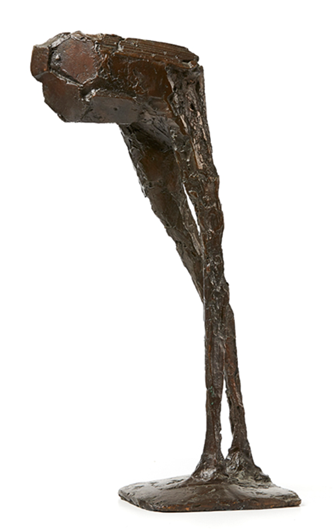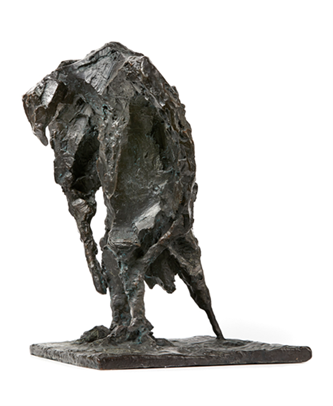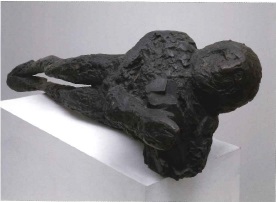Lesson Three: Elisabeth Frink’s Harbinger Bird III
GETTING YOUR EYE IN
Take a look at this 3D model of Frink’s Harbinger Bird III.
[TIP – click the arrow to load the 3D model, then use your left mouse button and cursor to rotate the image through 360 degrees. Or tap and use your finger to rotate on a touch screen,]Take a minute to clear your mind and simply look closely at this wonderful piece.
Look in silence for one minute.
What do you notice?
What does it make you think of?
Does it remind you of anything?
How does it make you feel? What do you see that makes you feel that way?
What do you make of it?
ACTIVITY
With these questions still fresh in your mind, write a short description, pulling together your visual observations and your more personal responses.
FROM THE ARTIST’S PERSPECTIVE
Browse this selection of Frink’s words and works. Note down what you learn about her preoccupation with birds.

h. 530 x w. 286 x d. 132 mm
Provided to the Sainsbury Centre in accordance with the wishes of the artist’s late son, Lin Jammet
© Frink Estate
At Chelsea] the forms I sculpted were the ones which were the most natural to me – animal and bird forms from Suffolk. However, I changed them enormously because they became much more like something else. They turned, almost, into a sort of bird-madness: quite fearsome, I think. Probably they were influenced by the aeroplanes I saw in the war – the equation was aeroplanes, flying machines flying men, birdman. I’m sure that was it.
Frink: A Portrait, Edward Lucie Smith, 1994.

h. 470 x w. 310 x d. 370 mm Weight: 20 kg
Provided to the Sainsbury Centre in accordance with the wishes of the artist’s late son, Lin Jammet
© Frink Estate
The very rough textured work I did then was mainly of bird forms which came from childhood memories; from being brought up in the country, mixed up with certain aspects of the war which of course affected me.
And the ideas: birdmen, birds which were rather horrific, predatory creatures: the animal forms were rather tortured. Plaster lent itself very much to this aggressive, rough texture.
Interview with Normal Rostenthal, Elisabeth Frink: Sculpture and Drawings 1952-1984. Exhibition Catalogue, Royal Academy, 1985, pp21-31.
They (the birds) changed a lot. As they went through, they became harbingers. More blunt. Kind of, rather prehistoric looking creatures, maybe the surviving shell of something, slightly blasted. It’s part raven. So it’s predatory.
All my sculptures after that for quite a while became armour plated. Partly because it’s the way I built up. I use bits of plaster that have been thrown out and put them together to make up these big areas of textured plates, so to speak… Bottoms of bowls and things like that. I used to pick up interesting pieces that I thought would fit together to make a carapace.
British Library Sounds. National Life Story Collection: Artists’ Lives. Elisabeth Frink. 4/7. 00.18:40 – 00:20:24.

h. 463 x w. 1772 x d. 405 mm
Provided to the Sainsbury Centre in accordance with the wishes of the artist’s late son, Lin Jammet
© Frink Estate
The birds at that time were really expressionist in feeling. That is, emphasis on beak, claws and wings – and they were really vehicles for strong feelings of panic, tension, aggression and predatoriness.
Interview with Bryan Robertson, in Elisabeth Frink Sculpture. Catalogue Raisonne, Jill Willder, Ed., 1984.
It was a mixture of two things. Being brought up in the country and being surrounded by wildlife which I incorporated as vehicles for what I want to say. And flight. So I was obsessed with flight and aeroplanes crashing. They crashed all around us. It was terrifying to see them coming down, the planes. I used to have bad dreams. We used to rush up the next day, like a lot of little ghouls, and we were allowed to pick up old bits of shrapnel, and parachute silk, and old bullet cases.
…
I still have dreams…they’re still rooted in fear.
…
Air raids were frightening. I mean, goodness me, you were bombed and machine gunned in Exmouth in Devon in broad daylight. I was walking along the front, and we just had to rush up the bank and throw ourselves down. So of course, there were aspects that were frightening.
My birds of prey became something else. They became like bits of shrapnel and flying things. You know with the very sharp beaks.
British Library Sounds. National Life Story Collection: Artists’ Lives. Elisabeth Frink. 2/7. 00.10:20 – 00:16:18.
READING
As you were browsing Frink’s quotes and works, you may noticed how Frink intertwines very personal chiildhood memories, particularly her wartime memories and growing up in the countryside, and draws on these to instil her work with strong, instinctive emotions and ideas.
In 2018, our Head of Collections, Calvin Winner, curated a major retrospective of Elisabeth Frink’s work titled Humans and Other Animals. Our ‘long read’ for this lesson is the essay that Calvin wrote for the catalogue. In it, he explores how these deeply rooted human feelings about birds are shared across time and cultures, and are expressed in a range of cultural forms from ritual objects and mystical poetry to popular film and mass media.
For this reading, I’m going to suggest that you don’t write notes. Just let the piece appeal to your imagination. Allow space for your own mental images and feelings about birds to come into play as you are reading.
ACTIVITY
Now that you’ve read Calvin’s essay, return to Frink’s Harbinger, and write a short piece about what it brings to mind for you. Think about your personal store of cultural references that it chimes with: that could be fine art, film, fairy tales, video games, cartoons, books, poems, TV programmes. It could be a newspaper photographs or news footage, or something you’ve seen on social media. It could be your personal mythology of dreams, childhood fears, phobias, memories, and experiences of the natural world. Don’t overthink this with the rational part of your brain, you need to allow room for that part of human experience that taps into our subconscious minds. Let go a bit, and see what happens!
GUEST PODCAST – WITH DR SARAH WADE
We’ve seen how Frink’s work was able to tap into the spirit of the times through a language both deeply personal and universal, creating a space for a powerful range of personal responses for the viewer. But does a work like Harbinger Bird III still have anything to tell us about ourselves and our relationship with the natural world?
Listen to this podcast where I posed the same question to Sarah Wade, Lecturer in Museum Studies in the School of Art, Media and American Studies at UEA. Sarah’s research focuses on human-animal relations in contemporary art, particularly with regards to ecological concerns. I asked her where those interests came from, and how that frames the way she looks at a work like Frink’s Harbinger Bird III. I was fascinated to hear her thoughts on how Frink blurs the boundary between human and animal, and the implications of that for us now.
OPTIONAL ASSIGNMENT
What does Harbinger Bird make you notice, feel and wonder about? Does it resonate with your experiences, your hopes and fears, as someone living in the twenty-first century? Do you find anything in it that helps you make sense of what it is to be human?
Start by writing down the first thoughts that come into your head. Don’t worry about grammar, or whether it would make sense to anyone else.
Take a short break, then read back through what you’ve written, being kind to yourself. Underline any ideas you find interesting, and write a second version that captures your personal response to the sculpture.
If you use social media, why not have a go at distilling one feeling or thought about the work that matters to you and posting it. Don’t forget to tag us @sainsburycentre #MooreToGormley.
FURTHER EXPLORATIONS
If you want to explore Frink and her career more generally, I would thoroughly recommend this wonderful episode of the podcast Sculpting Lives, with Jo Baring and Sarah Turner. This episode offer an important and comprehensive reappraisal of Frink’s career and her place in the history of British sculpture. Sculpting Lives podcast: Elisabeth Frink | Art UK
I would also heartily recommend dipping into the full interviews with Elisabeth Frink as part of the British Library Voices of Art project. Voices of art | People | Elisabeth Frink | The British Library (bl.uk). They make wonderful listening, and offer many insights into all aspects of the artist’s life and work.
Elisabeth Frink’s gallery was Messums, and they have a lovely Frink archive page on their website: Elisabeth Frink – Studio : Messums London
The Hauser and Wirth gallery have some interesting material relating to the Frink exhibition they held in 2017, ‘Transformation.’ There are a couple of films of the exhibition on the site. Elisabeth Frink Transformation – Hauser & Wirth (hauserwirth.com)
If you’re inspired to find out about some more British Women Sculptors, I’d recommend this episode of The Sculpture Podcast, made by Morley College for Women’s History Month, where they look at five public sculptures in London by women artists (although not Frink, sadly). The whole series is a delight. https://www.mixcloud.com/MorleyRadio/sculpture-podcast-episode-4/
